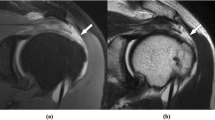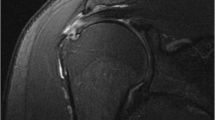Abstract
An experimental study was performed on cadaveric joint specimens of the shoulder to determine the accuracy of US and MRI in diagnosis of abnormalities of the rotator cuff. The value of different morphological criteria was evaluated for discrimination of degeneration as well as partial and complete disruption. A total of 38 surgically exposed specimens of the shoulder joint were examined by US, MRI and pathological methods visualising the tendons of the rotator cuff in same axial and longitudinal orientations. The three imaging modalities were reviewed separately by experienced examiners, respectively, who were blind to other results. Evaluation criteria consisted of signs of shape (thinning, thickening, discontinuity and absence of rotator cuff) and structure (changes in echogenicity in US, increased signal intensity in MRI, tissue changes in pathology). Findings in US and MRI were finally compared with pathology to assess sensitivity and specificity. Pathology demonstrated 4 full-thickness tears, 6 partial-thickness tears, 16 cases with degeneration and 12 normal rotator cuffs. Ultrasound showed pathological signs in all abnormal cuffs, and one MRI report was false negative. Specificity was 67 % in US (4 of 12 cases were false positive) and 100 % in MRI (no abnormal findings in healthy tendons). Discrimination of different pathological disorders of the rotator cuff was reduced in both methods. Using US only 10 of 16 cases of degeneration, 2 of 6 partial tears and 3 of 4 complete tears were correctly defined. Using MRI 13 of 16 degenerations, 3 of 6 partial tears and 3 of 4 complete tears were detected. The MRI technique failed to visualise intratendinous calcifications in all 3 cases. We conclude that MRI and US are both sensitive in detection of abnormalities of the rotator cuff. Ultrasound should be the primary diagnostic method in screening of shoulder pain because it is economic and fast. The MRI technique should be used secondary because it provides more information about extent of tendons and has lower risk of artefacts.
Similar content being viewed by others
Author information
Authors and Affiliations
Additional information
Received 15 April 1996; Revision received 29 July 1996; Accepted 31 July 1996
Rights and permissions
About this article
Cite this article
Bachmann, G., Melzer, C., Heinrichs, C. et al. Diagnosis of rotator cuff lesions: comparison of US and MRI on 38 joint specimens. Eur Radiol 7, 192–197 (1997). https://doi.org/10.1007/s003300050133
Published:
Issue Date:
DOI: https://doi.org/10.1007/s003300050133




